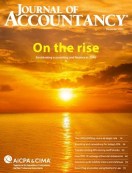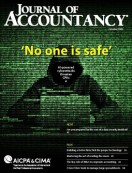- newsletter
- A&A FOCUS

Insights into the practical effects on CECL by FASB ASU 2025-05
The October A&A Focus webcast also examined considerations of using a cash-basis accounting method and considerations for auditing revenue.
Related
Key signals from the SEC-PCAOB conference point to a busy new year
GASB issues guidance on subsequent events
FASB publishes its taxonomies for 2026
The AICPA A&A Focus webcast on Oct. 8 continued its deep dive into practical issues shaping today’s accounting and assurance landscape. Hosted by Bob Durak, CPA, CGMA, director–A&A Technical Services for the AICPA, and Andrew Merryman, CPA, senior manager–A&A Technical Services, the program featured Julie Killian, CPA, principal, assurance and financial reporting at Rehmann; Curt Hurd, CPA, partner at Plante Moran; and Angela Newell, CPA, deputy managing director at BDO USA, each offering their perspectives on fundamental topics for today’s CPAs.
News updates in the A&A space
Durak opened with a series of key standard-setting and practice updates.
First to be discussed was FASB ASU 2025-06, Intangibles — Goodwill and Other — Internal-Use Software (Subtopic 350-40): Targeted Improvements to Accounting for Internal-Use Software, which modernizes 40-year-old guidance related to software to reflect agile development approaches rather than sequential waterfall models. Effective for fiscal years beginning after Dec. 15, 2027, the update introduces clearer capitalization and implementation guidelines that align with today’s iterative software practices.
He next highlighted FASB ASU 2025-07, which clarifies the accounting for non-exchange-traded derivative contracts and share-based noncash consideration received in revenue transactions. The ASU excludes from derivative accounting any non-exchange-traded contracts whose underlying variables relate to one of the contracting parties’ own operations. This ASU shares the same 2027 effective date.
Durak also noted a recently released FASB exposure draft addressing the initial measurement of paid-in-kind dividends on equity-classified preferred stock. Comments are due Oct. 27, and he again encouraged members to provide feedback, even if informal, emphasizing that both FASB and the AICPA value practitioner input on their respective proposed guidance.
In releases from the AICPA, Durak announced new Technical Questions and Answers covering the use of technology in an audit. These nonauthoritative Q&As clarify what types of automated tools can be used, what procedures may be performed through technology, and the auditor’s responsibilities when analyzing entire data populations.
He also discussed a new peer review exposure draft, PRSU No. 3, Modernizing Peer Review Administration Requirements, that would shift administration of peer reviews for firms operating under alternative practice structures to the AICPA’s National Peer Review Committee. The goal of the update is to establish consistency and enhanced oversight as private-equity and nontraditional firm models evolve. If approved by the Peer Review Board, the update would become effective soon, for peer reviews with years ending on or after Dec. 31, 2025. Comments are due Oct. 25.
Relief for expected credit loss complexity: FASB ASU 2025-05
Hurd, vice chair of the AICPA’s TIC, joined co-host Merryman to unpack FASB ASU 2025-05, which introduces simplifications to the current expected credit loss (CECL) model for accounts receivable and contract assets.
Hurd explained that CECL traditionally required entities to consider three components:
- Historical losses;
- Current conditions; and
- Reasonable and supportable forecasts.
Hurd explained that for smaller entities, that third component, the forecasting step, was the most onerous and difficult, noting that firms know their customers, but they don’t maintain macroeconomic data.
The new ASU provides two relief mechanisms:
- A practical expedient allowing entities to omit the forecasting element and assume current conditions persist over the asset’s life. This expedient simplifies calculations while retaining historical and current-condition adjustments. Hurd noted that all entities, both public and private, may elect this option.
- An accounting policy election (for private entities only) that permits use of subsequent cash receipts after year end but before issuance to estimate expected losses.
Hurd provided an example of the accounting policy election, explaining that if a company has $10 million in receivables at year end and collects $7 million by the following Feb. 28, only the remaining $3 million would be evaluated for loss allowance. The entity must disclose the evaluation cutoff date and the fact that the election was made. Further, this date may change annually, but it must be disclosed each time.
Hurd stressed that the accounting policy election cannot stand alone; it must be paired with the practical expedient. Together, the two options substantially reduce documentation and estimation burdens.
Hurd explained that for most private companies, the change in practice allowed by FASB ASU 2025-05 means fewer circular debates about forecasts that never materially change the result and that the change would likely shrink allowances modestly and make CECL much more workable.
In the webcast’s Q&A, he clarified that entities may still consider current economic conditions, providing evidence of an emerging recession as an example, so long as those factors exist at the balance-sheet date. However, forward-looking speculation would fall outside the expedient’s scope.
Hurd added that changing the evaluation date year to year is not a change in accounting policy, provided it is properly disclosed.
In addition to discussing FASB ASU 2025-05, Hurd provided the audience with background on TIC, one of the AICPA’s senior committees. Hurd explained that TIC is composed of about 15 practitioners from small and midsize firms and is currently chaired by another A&A Focus guest, Julie Killian.
TIC’s mission is to monitor accounting and auditing standard-setting activity, including the activities of FASB, GASB, and the AICPA’s Auditing Standards Board, and to evaluate those developments through the lens of how they affect smaller private companies and their auditors.
Because larger firms and public companies already provide extensive feedback to standard setters, TIC serves as a critical voice for smaller firms, ensuring their practical challenges and perspectives are represented. The committee then communicates feedback and recommendations to the standard-setting bodies to help prevent unintended consequences for smaller entities.
The broadcast also hosted two other expert guests.
Spotlight on special-purpose frameworks
Killian, a returning presenter, continued her series on non-GAAP and special-purpose frameworks (SPFs), which she began during the August broadcast. This session focused on the modified cash basis of accounting, comparing it with pure cash-basis presentations and discussing when each is most appropriate.
Killian emphasized that framework selection hinges on facts and circumstances, particularly the entity’s complexity, users, and available resources.
The cash basis, she explained, is literally like your checkbook — only transactions involving cash inflows or outflows are recorded. This method works best for very small or simple operations that prioritize liquidity over profitability and that lack a formal accounting infrastructure.
The modified cash basis adds limited accruals such as receivables, payables, fixed assets, or depreciation and produce a more complete, yet still practical, financial picture. Modified cash basis conveys more information without the full burden of GAAP, but consistency is key, and Killian noted that included accruals should be applied the same way each reporting period.
Because no authoritative guidance governs the modified cash basis, disclosure discipline becomes essential. Killian recommended listing modifications clearly, mirroring GAAP-style policy notes, and maintaining the same adjustments from year to year unless a genuine change in circumstances occurs.
She also cautioned against user confusion, noting that the biggest risk in any SPF is that a reader assumes the statements are GAAP. Labeling and footnote clarity are your safeguards.
Titles should explicitly identify the basis, for example, Balance Sheet — Modified Cash Basis. Comparable disclosure requirements should also be applied when similar transactions appear in GAAP financials. If a GAAP disclosure would be relevant, include it, Killian advised.
As entities grow, they may outgrow SPFs. Killian noted that transitions to GAAP often occur when external financing, investor interest, or succession planning requires comparability and transparency. A banker or buyer usually wants to see GAAP, but until then, a well-structured SPF can communicate what’s truly useful for smaller entities.
Auditing revenue: Estimates, evidence, and skepticism
Closing the program, Newell, a former chair of the AICPA’s Financial Reporting Executive Committee, returned to discuss auditing considerations in revenue recognition — the flip side of her earlier sessions on accounting under FASB ASC Topic 606. Note that her previous discussions on the FASB five-step revenue recognition model are available for AICPA members to replay.
Revenue, Newell reminded viewers, is often the most pervasive and judgment-laden area of an audit. Auditors face difficulties when management must make estimates, particularly around variable consideration and stand-alone selling prices (SSPs).
Many management teams believe they have observable SSPs when they do not. For example, Newell explained that an entity’s sales team can discount 50%, but that’s an estimate, not an observable SSP. However, when ranges are tight (e.g., within 10% to 15%), evidence may support observable pricing. Broader discretion requires estimation.
She illustrated the concept with real-world parallels, such as pharmaceutical pricing differences across jurisdictions. Multiple SSPs may exist if price differences are justified (e.g., regulated markets vs. negotiated markets). But when transactions occur only in bundles, auditors must test management’s estimation methods rather than accept list prices at face value.
Auditors should also evaluate whether SSP estimates comply with AICPA Statement on Auditing Standards No. 143, Auditing Accounting Estimates and Related Disclosures, which applies broadly and not only to fair value or impairment.
Auditors should understand how management is deriving estimates, assess any bias, and, if necessary, develop the auditors’ own expectation.
Beyond estimates, Newell urged auditors to perform walk-throughs of revenue processes, even in nonintegrated control environments. Such walk-throughs, although not required in GAAS, can reveal inconsistencies in contract terms and also may help calibrate sampling. She recounted examples where reviewing operational processes, such as how a moving company priced by mileage and weight, clarified contract performance obligations.
Newell warned that auditors should verify that client-prepared estimates are supported by management evidence and audit procedures are supported by their own evidence. Auditors must corroborate management explanations with documentation and maintain independence of thought, even when client conclusions “feel right.”
Her final message was timeless: Professional skepticism remains the auditor’s most critical tool.
Newell noted that auditors serve clients but that auditors can’t be part of the client, and she noted that gut-feel accounting gets auditors in trouble every time.
Looking ahead
Durak closed by previewing the Nov. 5 A&A Focus, which will feature Danielle Supkis Cheek, CPA, continuing her discussion on practical uses of artificial intelligence, and Jeanee Dee, CPA, on documenting a firm’s quality management implementation, including properly scaling the working papers. Durak reminded members to complete post-event surveys and share topic suggestions — feedback that directly shapes upcoming programs.
AICPA members are encouraged to attend these monthly events and review the accompanying newsletters for more in-depth coverage of these critical topics. Members can access archives of past sessions at the A&A Focus Series webpage.
— Dave Arman, CPA, MBA, is senior manager–Audit Quality at the Association of International Certified Professional Accountants. To comment on this article or to suggest an idea for another article, contact Jeff Drew at Jeff.Drew@aicpa-cima.com.



















